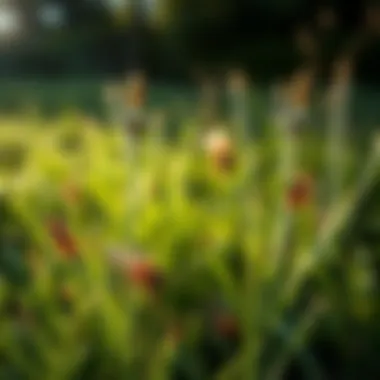Effective Lawn Pest Control Strategies for a Healthy Yard


Key Insights
Overview of the Topic
Managing pests effectively is crucial for maintaining a healthy lawn. The balance of ecosystems tends to get disrupted when pests intrude, leading to undesired environments and diminished plant vitality. This article takes a closer look at various pest control strategies that are effective yet considerate of ecological balance. From understanding who the culprits are to finding inventive solutions, each aspect deserves consideration.
Importance in Agriculture/Horticulture/Agronomy
Not merely a concern for homeowners, effective pest management holds great significance in agriculture and horticulture as well. Reconciling pest control with sustainable practices can greatly enhance crop yield and improve the overall quality of life for many in agronomic professions. Moreover, it aligns agricultural practices with the principles of sustainability, ensuring that future generations inherit a vibrant ecosystem.
Sustainable Practices
Eco-Friendly Techniques
More and more, people are turning towards sustainable practices that reduce reliance on chemical solutions. Methods such as introducing predatory insects, implementing companion planting, or utilizing natural repellents are gaining traction. Even culturally significant practices, like crop rotation, prove invaluable in managing pests while enriching the soil.
- Predatory Insects: Ladybugs, lacewings, and parasitic wasps can be powerful allies.
- Companion Planting: Certain plants naturally repel pests. For instance, marigolds help keep nematodes at bay while boosting neighboring plants’ growth.
- Natural Repellents: Materials like neem oil or diatomaceous earth can deter unwanted visitors without harming beneficial organisms.
Case Studies on Sustainability
One notable example involves a farmer in Iowa who adopted an integrated pest management (IPM) system. By utilizing crop rotation and non-chemical treatments, he saw a 30% reduction in pest infestations while improving soil health. Similarly, a California vineyard utilized beneficial insects like green lacewings to manage aphid populations effectively. These examples serve as reminders that sustainable methods can lead to significant improvements.
Tools & Resources
Essential Equipment and Technologies
Investing in the right tools can make pest management not just effective but efficient too. Tools ranging from soil testers to software for tracking pest populations can help keep lawns and gardens thriving.
- Soil Test Kits: They help determine nutrient deficiencies.
- Pest Identification Apps: These apps, such as PlantSnap and iNaturalist, assist in identifying pests quickly.
- Natural Sprayers: A good sprayer ensures even distribution of natural treatments.
Recommended Books and Readings
A selection of insightful literature can enhance one’s knowledge and approach to pest control. Some notable mentions include:
- "The Garden Primer" by Barbara Damrosch
- "Teaming with Microbes" by Jeff Lowenfels & Wayne Lewis
- "Pest Control for the Home and Garden" by Rachael A. Williamson
For more in-depth studies, websites such as University of California Agriculture and Natural Resources, and National Integrated Pest Management Network serve as valuable resources.
Prologue to Lawn Pest Control
Effective lawn pest control not only protects your green oasis from unsightly pests but also ensures the overall health of your lawn. As any seasoned gardener will tell you, the lushness and vibrancy of a lawn can be compromised by a range of troublesome insects and diseases. These invaders, if left unchecked, can reduce the aesthetics and vitality of your grass, leading to a patchy and sickly appearance.
Importance of Lawn Pest Management
Managing pests is crucial for maintaining a thriving lawn. Beyond appearance, healthy lawns contribute to environmental benefits such as soil erosion prevention and air quality improvement. Every gardener needs to be proactive, not reactive. Just imagine nurturing your lawn through meticulous care, only to have it ravaged by pests. Preventive measures save time and resources, ensuring that your efforts in mowing and watering do not go to waste.
Moreover, a pest-ridden lawn can also lead to increased maintenance costs. Dealing with an infestation often requires more intensive measures—including chemical treatments, which can add up quickly. Putting in place a well-thought-out pest management strategy is an investment in your lawn's long-term health, rather than a fleeting fix.
Overview of Common Lawn Pests
There’s no shortage of pests that can wreak havoc on your turf. Some of the most common culprits include:
- Grubs: These larvae chow down on grassroots, creating brown patches.
- Chinch Bugs: They suck the life out of grass blades, leading to a thirsty-looking lawn.
- Armyworms: With their voracious appetite, armyworms can decimate growth in no time.
- Moles: While they may seem innocent, moles can create a mess of tunnels and disrupt the root system.
- Turf Caterpillars: These guys can munch through a lawn overnight, leaving behind tell-tale signs of defoliation.
Understanding the landscape of potential threats prepares you for when those pests make their unwelcome entrance. By learning about these common invaders, you gain the upper hand in controlling them. A well-informed gardener is often a successful one.
"An ounce of prevention is worth a pound of cure"—This old saying rings especially true for maintaining a healthy lawn.
As we dive deeper into this article, the significance of first identifying these pests, then employing a range of strategies tailored to effectively manage them will become clearer. This knowledge not only positions you as a competent caretaker of your lawn but also fosters a sustainable environment conducive to growth.
Identifying Lawn Pests
Identifying pests in your lawn is a critical first step towards effective pest management. Understanding what you're dealing with allows for targeted responses, thereby increasing the efficacy of your pest control efforts. Not only do different pests require different approaches, but their life cycles and habits are also unique, meaning what works for one might not be effective for another. By correctly identifying lawn pests, you can not only save time and resources but also minimize any negative impacts on your environment.
Physical Identification of Pests
Recognizing the physical signs of pests can be an invaluable skill. For instance, caterpillars often leave a trail of chewed leaves behind, making them easier to spot. Identifying these signs early on can prevent an infestation from getting out of hand.
To effectively identify pests, here are several strategies:


- Visual Inspection: Regularly check your lawn for unusual color changes or growth patterns.
- Seek Out Signs: Look for any droppings, webs, or other indicators that pests are present.
- Use Identification Guides: Refer to field guides or online databases that can help you pinpoint specific pests based on images and descriptions. Websites like Wikipedia have extensive resources on common pests.
Keep in mind that while some pests may be clearly visible to the naked eye, others might require a closer look through a magnifying glass or microscope. Whichever approach you take, detailed observation can yield significant insights into your yard’s health.
Behavioral Patterns of Common Pests
Understanding the behavioral patterns of pests can further help in their identification and subsequent control. Many pests exhibit specific behaviors that can be tracked over time. For instance, some insects are more active during certain times of the day. The lawn grub, for example, tends to feast at night, while adult beetles may be seen during daylight hours.
Considering the lifecycle stage of pests can also shed light on their behaviors.
- Feeding Habits: Some pests, like aphids, cluster on the undersides of leaves to feed, while others, like Japanese beetles, tend to devour entire leaves.
- Movement Patterns: Noticing whether pests fly, crawl, or burrow can assist in identifying them.
- Seasonal Activity: Certain pests are more prevalent in specific seasons. A rise in numbers of grubs in the fall can suggest possible problems come spring.
Ultimately, observing and understanding these patterns can aid in pinpointing pest problems quickly. Be diligent in your observations; over time, you’ll develop an intuition about what’s going on in your lawn. Monitoring pest behavior not only helps with identification but can also inform the development of effective control strategies.
"The best defense is a good offense.” By recognizing and respecting the patterns of pests, you can stay ahead in the game of lawn care.
For further reading on behavioral patterns of pests and effective strategies, consider checking Britannica or similar educational resources.
Traditional Pest Control Techniques
Understanding traditional pest control techniques is vital for anyone looking to maintain a lush lawn. These methods, often time-tested and widely practiced, provide a robust framework for managing pest populations effectively. There’s a certain comfort in knowing that while nature can be unpredictable, you have strategies in place to combat those pesky intruders threatening your green paradise.
Chemical Control Methods
Discussing chemical control methods leads us into the diverse array of options available to address lawn pests. Chemical pesticides come in multiple varieties and serve specific purposes in pest management.
Types of Chemical Pesticides
Chemical pesticides can be categorized into several key types, including insecticides, herbicides, and fungicides. Each type specializes in tackling different garden adversaries—whether it's insects munching on leaves, weeds competing for nutrients, or disease-causing fungi wreaking havoc on grass.
- Insecticides are designed to target bugs and critters that can turn a verdant lawn into a battleground. Common varieties include pyrethroids and neonicotinoids, both well-regarded for their efficacy. While effective, a concern about these can be their impact on beneficial insects, like bees, which play a critical role in the ecosystem.
- Herbicides, on the other hand, focus on controlling weed populations. Contact herbicides swiftly eliminate existing weeds, while systemic ones work their way through the plant to halt growth at the roots.
- Fungicides are essential for managing not just aesthetic wellness, but overall lawn health. Fungal diseases spread quickly and target grass, leading to patches and discoloration. Key characteristics of these pesticides are their fast-acting nature—providing immediate results often makes them a popular choice for homeowners in distress. However, it’s crucial to read labels and understand the potential ramifications on local wildlife.
Application Techniques
How pesticides are applied can significantly influence their effectiveness and safety. Mastering application techniques is just as crucial as choosing the right product.
Techniques include:
- Spraying: Using handheld or motorized sprayers allows for precision targeting. It's essential to keep in mind that wind can drift the chemicals, so choose calm weather for this method.
- Granule Application: Spreading granules can be advantageous for controlling pests on larger lawns. These often dissolve when watered, releasing their active ingredients directly where they do the most good.
- Soil Injection: This method involves inserting the pesticide into the ground directly, useful for persistent pests like grubs. It minimizes the risk of exposure to non-target organisms.
The effectiveness of any technique depends on proper calibration of equipment and adherence to manufacturer instructions. Improper application can lead to either ineffective treatments or environmental harm. It’s a balancing act that requires forethought and care.
Advantages and Disadvantages
Like two sides of a coin, traditional pest control techniques come with their own set of advantages and disadvantages.
"The effectiveness of chemical control can’t be ignored, but caution should be exercised. Balance is essential."
Advantages:
- Quick Results: Chemical pesticides often show results within hours or days, providing immediate relief.
- Broad Spectrum: Many of these chemicals can treat a wide range of pests, making them versatile tools in any lawn care arsenal.
Disadvantages:
- Environmental Concerns: Impact on non-target species and local ecosystems can be significant, necessitating responsible usage.
- Pest Resistance: Over time, repeated use can lead to pests developing resistance, creating a long-term problem.
For further reading and resources on pest management techniques, you can visit Wikipedia on Lawn Care or check out Penn State University’s guide on Pest Management if you seek more detailed insights.
Organic and Eco-Friendly Pest Control
In today’s world, where the balance between ecological health and agricultural productivity is more critical than ever, organic and eco-friendly pest control represents a pivotal approach to managing pests without compromising the environment. This method emphasizes the importance of sustainability, minimizing chemical use, and promoting a healthier ecosystem. Utilizing natural ingredients and methods does not merely prevent pests, but also fosters a vibrant lawn and soil health, which in turn supports biodiversity.
Organic practices often lead to a more resilient lawn, one that can withstand pest pressures without the need for synthetic interventions. These strategies contribute to a holistic ecosystem where beneficial insects thrive, thus playing a vital role in pest management themselves. With the evolving understanding of environmental impacts, implementing organic pest control techniques has gained momentum among agricultural farmers and enthusiasts alike.
Natural Pest Deterrents
Natural pest deterrents offer a dual advantage: they repel unwanted pests while posing minimal risk to beneficial insects and the environment. Commonly used deterrents include neem oil, diatomaceous earth, and garlic sprays. Each of these has a unique mechanism; for instance, neem oil disrupts the life cycle of pests by interfering with their hormone systems. This allows lawn enthusiasts to employ proactive methods that either prevent infestations or significantly reduce them without resorting to harmful chemicals.
Key Benefits of Natural Deterrents:
- Safety: They are non-toxic to humans and pets, making them safer options for households that prioritize health.
- Ecosystem Support: By repelling pests naturally, they encourage the survival of beneficial insects like pollinators and predatory species that help maintain pest populations naturally.
- Soil Health: Many natural deterrents inadvertently contribute to overall soil quality and health, enhancing the growth of grass and plants.


Homemade Solutions
Crafting your own homemade pest control solutions can often be cost-effective and efficient. Many enthusiasts find satisfaction in using accessible ingredients to tackle lawn pests. Among these solutions, essential oils and soap solutions stand out for their efficacy and ease of use.
Essential Oils
Essential oils are derived from plants and are known for their potent properties. When discussing their role in pest control, their key characteristic lies in their ability to repel various pests effectively due to their strong aromas. Popular options like peppermint or lavender oils not only serve as delightful fragrances but also deter mosquitoes, flies, and other nuisances.
The unique feature of essential oils is their concentration. A small amount can go a long way in deterring pests, making them economical from a long-term perspective. However, care should be taken as some essential oils can be phytotoxic or harmful to plants when applied excessively or improperly. Balancing their use is crucial to reap benefits while minimizing risks.
Soap Solutions
Soap solutions present another practical solution in the realm of homemade pest control. These solutions typically utilize liquid soap (such as castile soap) mixed with water, creating a spray that suffocates soft-bodied insects like aphids and mites upon contact. The key characteristic of soap solutions is their simplicity and effectiveness; they can be made quickly and with minimal ingredients.
One advantage of soap solutions is that they are biodegradable, thus not persisting in the environment and adversely affecting non-target species. However, a word of caution—soap solutions may not be suitable for all types of plants, as some may experience leaf burn, particularly during hot weather. Always test on a small area before widespread application.
In summation, embracing organic and eco-friendly pest control strategies not only aids in managing pests more effectively but also champions a responsible approach towards lawn care. With natural deterrents and chemistry-free solutions such as essential oils and soap solutions at one’s disposal, lawn care can transition from being merely reactive to a proactive means of nurturing a vibrant and healthy environment.
Integrated Pest Management (IPM)
Integrated Pest Management (IPM) is crucial in maintaining a healthy lawn ecosystem. It is not just about controlling pests; it focuses on the entire environment. IPM combines different strategies for effective pest control. This approach minimizes chemical use, thus preserving beneficial organisms in the soil and surrounding areas. Moreover, it promotes sustainable practices, which resonate with an increasing number of environmentally conscious gardeners.
Principles of IPM
Monitoring and Assessment
Monitoring and assessment are fundamental aspects of IPM. This practice involves regularly checking for pests and damage in your lawn. By doing so, you can identify issues early before they snowball into significant problems. The key characteristic of monitoring is its proactive nature. Rather than reacting to infestations, you observe and analyze pest populations in real-time. This makes it a beneficial choice for effective lawn management.
The unique feature here is the use of specific tools like traps and scouting reports. These enable accurate pest identification, helping to determine what’s actually munching away at your grass. The advantages of monitoring include timely interventions and potentially lower costs associated with treatments. On the flip side, consistent monitoring requires time and attention—it’s not a one-and-done scenario. However, for enthusiasts and farmers, it’s more than worth the effort.
Prevention Strategies
Prevention strategies play another vital role in IPM. They aim at reducing the chances of pest establishment. This can be anything from rotating crops to adjusting watering schedules. The key characteristic of these strategies is their focus on creating an environment less conducive to pests. By improving lawn health and resilience, you stand a much better chance against pest invasions.
A unique aspect of prevention strategies includes cultural practices, like selecting pest-resistant grass varieties. This method can lead to a happier, healthier lawn with less intervention. The benefits here are twofold: you reduce pest populations and foster a thriving environment. However, implementing these strategies might require changes to long-held lawn care routines, which some might find challenging.
Combining Techniques for Optimal Results
In the realm of lawn care, combining various techniques within IPM is a recipe for success. It is all about finding the right balance between chemical, biological, and cultural practices. Each method complements the other, increasing your lawn's ability to withstand pest pressures.
For example, integrating regular monitoring with organic treatments can yield optimal results. If you notice an uptick in pest activity, you can quickly pivot to targeted organic solutions instead of broad-spectrum chemicals. This not only preserves the integrity of your lawn but also supports biodiversity. Plus, it gives you peace of mind in knowing you’re contributing to a healthier planet.
Remember, the goal of IPM is not just to eliminate pests but to create a balanced ecosystem where both plants and beneficial organisms can thrive alongside one another.
Seasonal Considerations in Lawn Pest Control
Seasonal changes hold significant sway over pest behaviors, activities, and the overall health of your lawn. Recognizing these seasonal shifts equips gardeners and farmers with the necessary tools and knowledge to adjust their pest management strategies accordingly. A well-timed approach not only helps in effectively managing pests but also ensures a thriving lawn throughout the year. This section delves into the specific challenges and techniques relevant to spring, summer, and fall, empowering readers to tackle each season with confidence.
Spring: Timing and Techniques
As the chill of winter retreats, the landscape begins to stir with life. Spring is a crucial period for lawn care, with various pests emerging as temperatures rise. The warmth signals the awakening of pests that may have hibernated, including grubs and various leaf-eaters. Monitoring pest activity closely during this season is vital.
- Timing is Key: Begin your pest management efforts as early as late March to early April. This preemptive approach can help nip potential infestations in the bud.
- Assessment: Conduct a thorough assessment of your lawn’s health. Look for signs of pests like chewed leaves, symmetrical holes, or discoloration.
- Techniques: Use chemical options judiciously if necessary, but consider starting with natural deterrents. For example, introducing beneficial nematodes can control grub populations effectively without harming the ecosystem.
During this time, it’s also beneficial to enhance lawn resilience. Aeration and overseeding can promote a healthier turf, making it less susceptible to pest invasion.
Summer: Vigilance and Management
Summer, with its heat and humidity, can create a perfect storm for lawn pests. Insects such as chinch bugs and armyworms become more active, potentially wreaking havoc on your lawn if left unchecked.
- Consistency is Crucial: Regular inspections are essential. Pests often multiply quickly, so a proactive rather than reactive stance is necessary during the scorching months.
- Pest Management Strategies: If you observe signs of infestation, apply targeted treatments. This could be chemical treatments or organic ones depending on your preference. For instance, insecticidal soap can be effective against soft-bodied pests.
- Water Wisely: Ensure your watering strategy does not encourage pest activity. Early morning is typically the best time to water, reducing the risk of moisture-loving pests thriving.
Vigilance in summer makes all the difference. Keeping a keen eye on your lawn not only protects it from immediate threats but helps mitigate long-term pest issues.
Fall: Preparation for Winter
As autumn descends, the pressure from pests doesn’t entirely dissipate. Fall is a significant time to fortify your lawn against winter invaders and prepare for the next growing season.
- Clean Up: Rake up leaves and debris, as these can provide shelter for overwintering pests. Ensure your lawn is clean to avoid encouraging pest populations.
- Final Treatments: Applying a preventative insecticide can deter pests that seek to overwinter in your lawn. This is a proactive measure to minimize springtime infestations.
- Healthy Practices: Fertilizing your lawn in the fall builds stronger roots and prepares it for enduring the harsh conditions of winter, ultimately making the lawn less hospitable to pests.
Moreover, consider planting cover crops in garden areas. They can help suppress weeds, break pest cycles, and improve soil health, making your pest management strategy even more robust.


“Effective lawn pest control is less about fighting pests and more about creating an environment where they cannot thrive.”
Undoubtedly, seasonal considerations in pest management are crucial for achieving a healthy lawn. Tailoring your strategies to accommodate the natural rhythms of each season sets the foundation for a resilient and thriving outdoor space. By doing so, you create an environment that fosters growth while minimizing the chances of pest invasion.
Lawn Care Practices to Prevent Pests
Lawn pest control is not solely about fighting battles when the enemy is at your gates. Establishing solid lawn care practices is your first line of defense and can significantly reduce the risk of pest outbreaks. Through consistent and effective care, one can build a resilient lawn that is not just healthy, but also less attractive to pests. The connection between proactive lawn care and pest prevention cannot be overstated. A well-maintained lawn reflects a healthy ecosystem, where plants can thrive, and pests are naturally kept at bay.
Proper Mowing Techniques
Mowing isn't just about keeping the grass length neat; it serves multiple purposes aimed directly at pest control. Proper mowing techniques include cutting grass to the right height, using sharp blades, and varying mowing patterns. Grass that is too short can stress the plants, making them vulnerable to pests like grubs or even fungal infections. Keeping grass at a height of around three inches allows roots to grow deeper, providing a stronger foundation and making it more difficult for pests to establish themselves.
- Regular Mowing: Aim to mow frequently and avoid cutting more than one-third of the grass blade in a single pass.
- Sharp Blades: Investing in a good mower with sharp blades ensures clean cuts, reducing the chances of diseases that pests often thrive in.
- Varying Patterns: Changing your mowing direction regularly can prevent soil compaction and promote a healthier lawn overall.
Watering Strategies
Watering techniques play a crucial role in overall lawn health and pest deterrence. Bugs love damp, poorly drained areas, as well as overwatered lawns. On the flip side, underwatering can stress grass, making it more susceptible to pest invasions. Here are some tips for effective watering:
- Deep and Infrequent Watering: Watering deeply once or twice a week encourages deep root growth. This not only helps your lawn survive drought situations but also makes it less appealing to pests.
- Timing is Key: Try watering in the early morning hours between 6 AM and 10 AM. This reduces evaporation and gives grass ample time to dry out during the day, keeping pest habitats at bay.
- Use a Rain Gauge: Monitoring rainfall helps in adjusting your watering schedule, thus preventing overwatering.
"Proper mowing and watering can save a lawn from performance drops that often lead to pest problems."
Fertilization Practices
Fertilization is yet another important aspect of lawn care that can contribute to pest prevention. Proper fertilization ensures that your lawn receives the nutrients needed to thrive, ultimately affecting its resilience against pests. When planning your fertilization strategy, consider these aspects:
- Soil Testing: Before you start pouring in fertilizers, a soil test can provide valuable insights into nutrient deficiencies and soil pH levels. This ensures you use the right fertilizers for your lawn’s specific needs.
- Slow-Release Fertilizers: Opting for slow-release or organic fertilizers not only gives your lawn a steady nutrient supply but also reduces the risk of nutrient runoff, which can degrade soil health.
- Timing Your Applications: Fertilize your lawn during the growing season—usually in spring or early fall—to maximize nutrient uptake and avoid pest infestations.
Using well thought-out lawn care practices can create an environment that nurtures healthy grass. In turn, a healthy lawn reduces the likelihood of pests settling in. Keeping your lawn healthy is like having a shield against the myriad of pests that can harm it.
For more information on lawn care practices, you might consider checking resources from the USDA or local agricultural extensions like those found at Extension.org. These provide tailored advice suited for specific regional grasses and pest management.
Evaluating Pest Control Efficacy
Evaluating the effectiveness of your pest control efforts is a crucial step that often gets overlooked. As we navigate the myriad of strategies available, it's imperative to ensure that the methods employed yield positive results. Not only does this provide peace of mind, but it also allows for a better allocation of resources, whether that be time, money, or effort. A lack of thorough evaluation could lead to repeated mistakes, wasted resources, and ongoing pest problems.
In pest control, success isn't just about how many pests you eliminate; it’s about maintaining a healthy lawn over the long haul. By monitoring results post-application, one can identify patterns in pest behavior and potentially uncover underlying issues that contribute to pest outbreaks.
Post-Application Monitoring
Monitoring the lawn after pesticide application is fundamental to determining effectiveness. This stage assesses the immediate impact of the chosen method. Here's what you should focus on:
- Visual Inspection: Regularly check for pest activity. Look for signs like wilting, discoloration, or any visible pests.
- Comparative Analysis: Compare the areas treated with those that haven’t been treated. This will help to gauge how well the application worked.
- Soil Testing: Sometimes, the soil itself can harbor pests or their eggs. Testing the soil post-treatment can reveal lingering problems that need attention.
- Watering and Weather Patterns: Observe how irrigation influences pest control. Overwatering or drought can impact pest populations differently.
By continually monitoring, you'll develop an understanding of what works best in your unique environment. The method you apply might excel one season but fall short another, depending on numerous ecological factors. As the old saying goes, "What gets measured, gets managed."
Adjustments for Future Control
The key to effective lawn management is not just recognizing what works but also learning from what doesn't. When pests continue to be a nuisance, or when new ones appear, adjustments become necessary. Here are specific considerations to apply:
- Reviewing Strategies: Consider the techniques previously employed. Were they consistent with established best practices? If not, it might be time to refresh your approach.
- Alternative Treatments: Don’t hesitate to explore new methods or products. Considerations of integrated pest management may lead you to natural deterrents that were overlooked before.
- Seasonal Adjustments: Each season brings different challenges. Adjust your strategies according to changes in temperature, rainfall, or pest hibernation patterns.
- Education: Stay informed about emerging pest control technologies or research. Engaging with community resources, such as local agricultural extensions or gardening clubs, can provide insights into what’s working and what isn’t in your area.
Proper evaluation might seem tedious, but it's truly one of the most effective ways to ensure long-term success in pest management. More than just a quick fix, it's about laying a strong foundation for your lawn’s health.
Evaluating pest control efficacy is akin to taking the pulse of your lawn. Without it, you’re simply guessing, and that can cost you in the long run.
For further reference on pest control management strategies, check out Wikipedia on Pest Management or engage with communities on Reddit for personal insights and tips.
Ending and Future Directions
In the ever-evolving realm of lawn care, understanding the delicate balance of pest control is paramount. The techniques discussed in this article form the backbone of effective lawn management, ensuring that your green oasis remains healthy and vibrant. The key takeaway is that pest management isn’t merely about extermination; it revolves around creating a balanced ecosystem that promotes the health of your lawn while minimizing ecological harm.
Emerging Trends in Pest Control
The landscape of pest control is shifting, with new methods emerging that prioritize not just effectiveness but also sustainability.
- Biological Control: This strategy harnesses natural predators or parasites to control pest populations. For instance, beneficial insects like ladybugs can keep aphid populations in check, offering a chemical-free solution.
- Technology Integration: Innovations such as drone surveillance or sensors for moisture levels are becoming common. Drones can pinpoint areas of pest activity, allowing for targeted treatments that reduce pesticide use.
- Genetic Engineering: Some scientists are developing genetically modified plants that are resistant to specific pests. This could mean fewer pesticides applied in the long run.
Monitoring and adapting to these trends will be crucial for anyone involved in lawn care, as embracing these techniques not only enhances effectiveness but also showcases a commitment to sustainable practices.
Long-Term Sustainability Considerations
Looking ahead, sustainability in lawn pest control is not just a trend; it's a necessity. Here are some considerations to keep in mind:
- Soil Health: A healthy soil ecosystem can naturally repel many pests. Regular testing and organic nourishment of the soil can foster beneficial microorganisms.
- Biodiversity: Encouraging a variety of plants can attract beneficial insects and reduce the prevalence of harmful pests. Monocultures can often lead to pest outbreaks.
- Water Management: Overwatering can create lush environments ideal for pests like mosquitoes. Proper irrigation that promotes healthy root systems will combat this issue.
- Education and Community Involvement: Sharing knowledge with fellow garden enthusiasts and participating in local workshops can help amplify sustainable practices in your community.
The future of lawn pest control lies in integrating these elements into daily practices. While it's essential to remain vigilant against pests, the approach should always prioritize the long-term health of the ecosystem. Keeping abreast of emerging trends and sustainability practices not only aids in the cultivation of a thriving lawn but also contributes positively to the environment at large.







